Let me start writing the content now.Traditional fireplaces represent timeless elegance and enduring warmth in home design, combining centuries-old craftsmanship with practical heating solutions. The Victorian era brought ornate cast iron surrounds and intricate tile work, while Arts & Crafts movement emphasized natural materials like stone and brick. Today's homeowners appreciate traditional fireplace designs for their authentic character, with brick and stone surro unds remaining popular choices that blend rustic charm with modern functionality. These classic heating features serve as focal points that anchor living spaces, offering both aesthetic appeal and genuine warmth. Understanding the various traditional fireplace styles, materials, and maintenance requirements helps you create the perfect gathering place that honors historical craftsmanship while meeting contemporary comfort standards.
1. Classic Brick Fireplace Surrounds

The enduring appeal of brick fireplaces stems from their perfect balance of durability, affordability, and timeless charm. Brick provides excellent heat retention while offering diverse color options from traditional red to weathered vintage tones. These versatile fireplace surrounds complement various architectural styles, from rustic farmhouse to contemporary minimalist designs. To maximize your brick fireplace's impact, consider the pattern arrangement—running bond creates classic appeal, while herringbone or basket weave patterns add visual interest. Regular maintenance involves checking mortar joints for cracks and cleaning soot buildup with specialized masonry cleaners. For modern updates, limewashing or painting can transform dated brick into fresh, contemporary focal points while preserving the authentic texture.
2. Natural Stone Fireplace Elegance
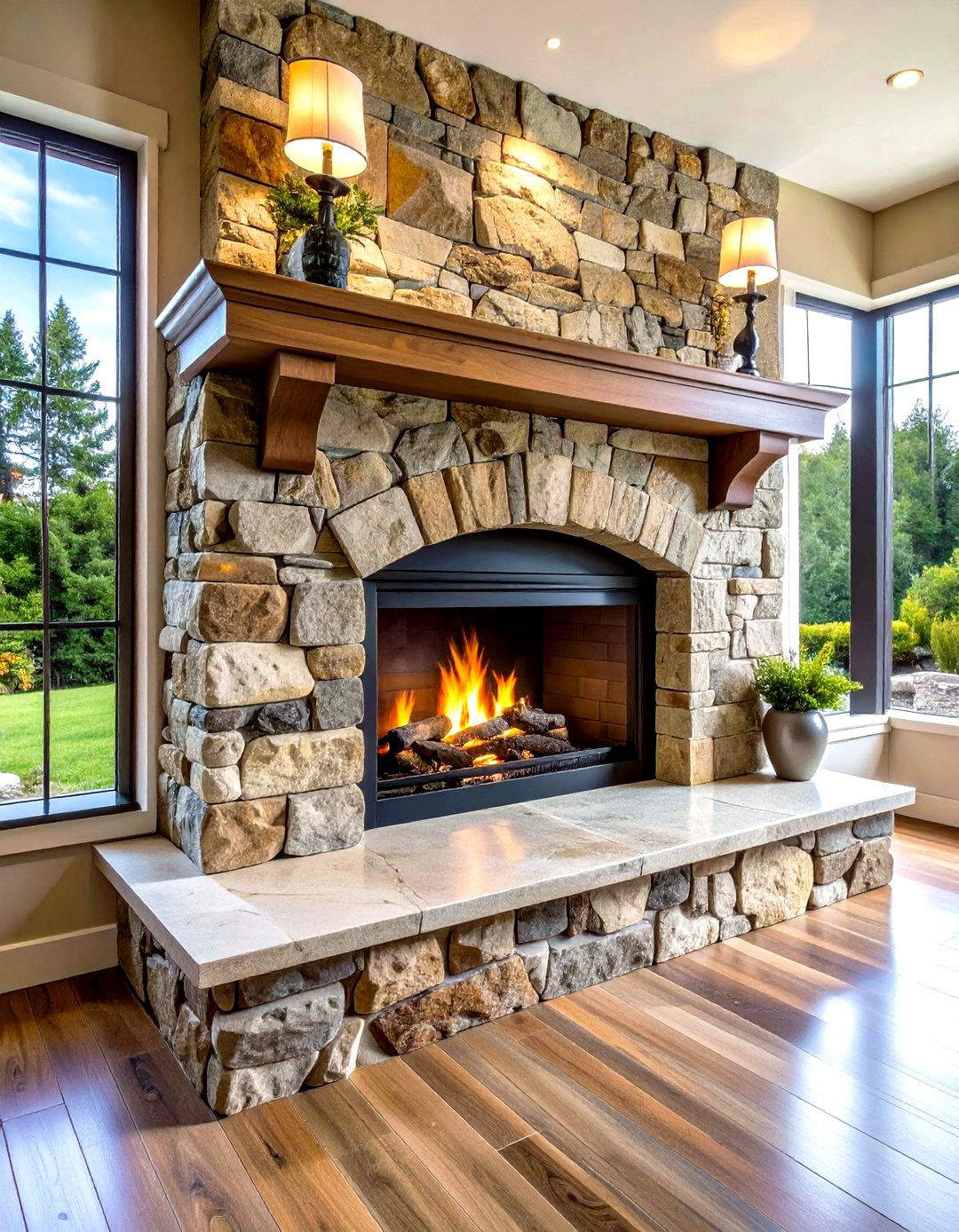
Stone fireplaces bring organic beauty and substantial presence to any living space, connecting interiors with nature's raw splendor. Options range from polished marble for luxury appeal to rustic fieldstone for country charm, with limestone offering durability and heat resistance. Natural stone variations include granite with subtle sparkle, limestone with historical significance, and marble with elegant veining patterns. The installation requires professional expertise due to weight considerations and precise fitting. Regular sealing protects stone surfaces from soot stains and maintains their natural beauty. Choose stone colors that complement your room's palette—neutral tones provide versatility, while dramatic dark stones create striking focal points. Professional cleaning ensures longevity and preserves the stone's inherent character.
3. Victorian Fireplace Grandeur
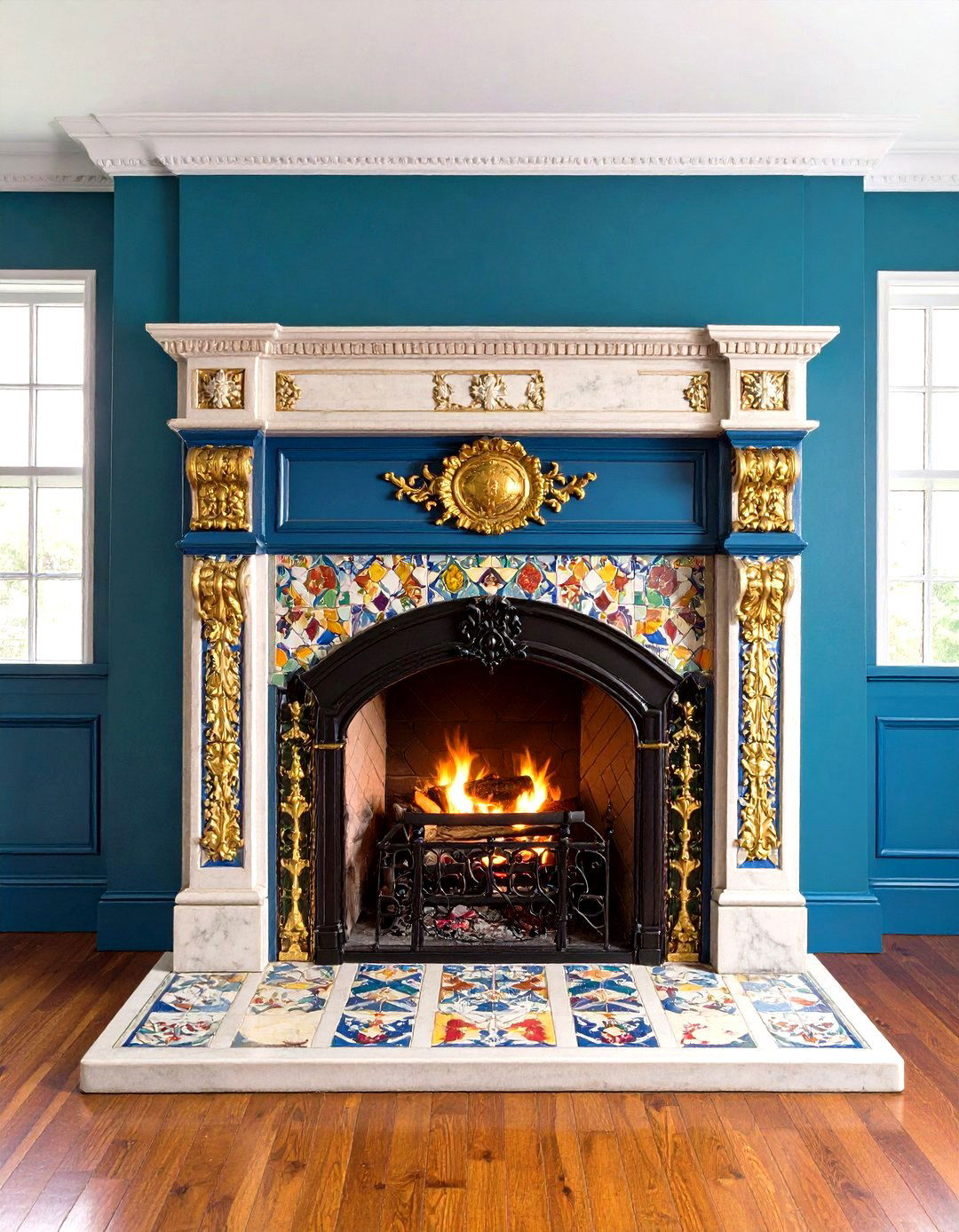
Victorian fireplaces epitomize ornate craftsmanship with their elaborate details, decorative tiles, and rich materials that defined an era of prosperity. These designs featured intricate cast iron surrounds, marble mantels, and elaborate tile work with vibrant colors and detailed patterns. Victorian fireplace styles evolved throughout Queen Victoria's 64-year reign, from classical Georgian influences to more elaborate floral motifs and later geometrical designs. Popular tile materials included encaustic tiles with handmade patterns and transfer-printed tiles for mass-produced detailed designs. To authentically restore a Victorian fireplace, research the specific period and maintain original proportions. Modern reproductions capture this elegance while meeting contemporary safety standards, offering homeowners the grandeur of Victorian design with updated functionality.
4. Colonial Fireplace Simplicity
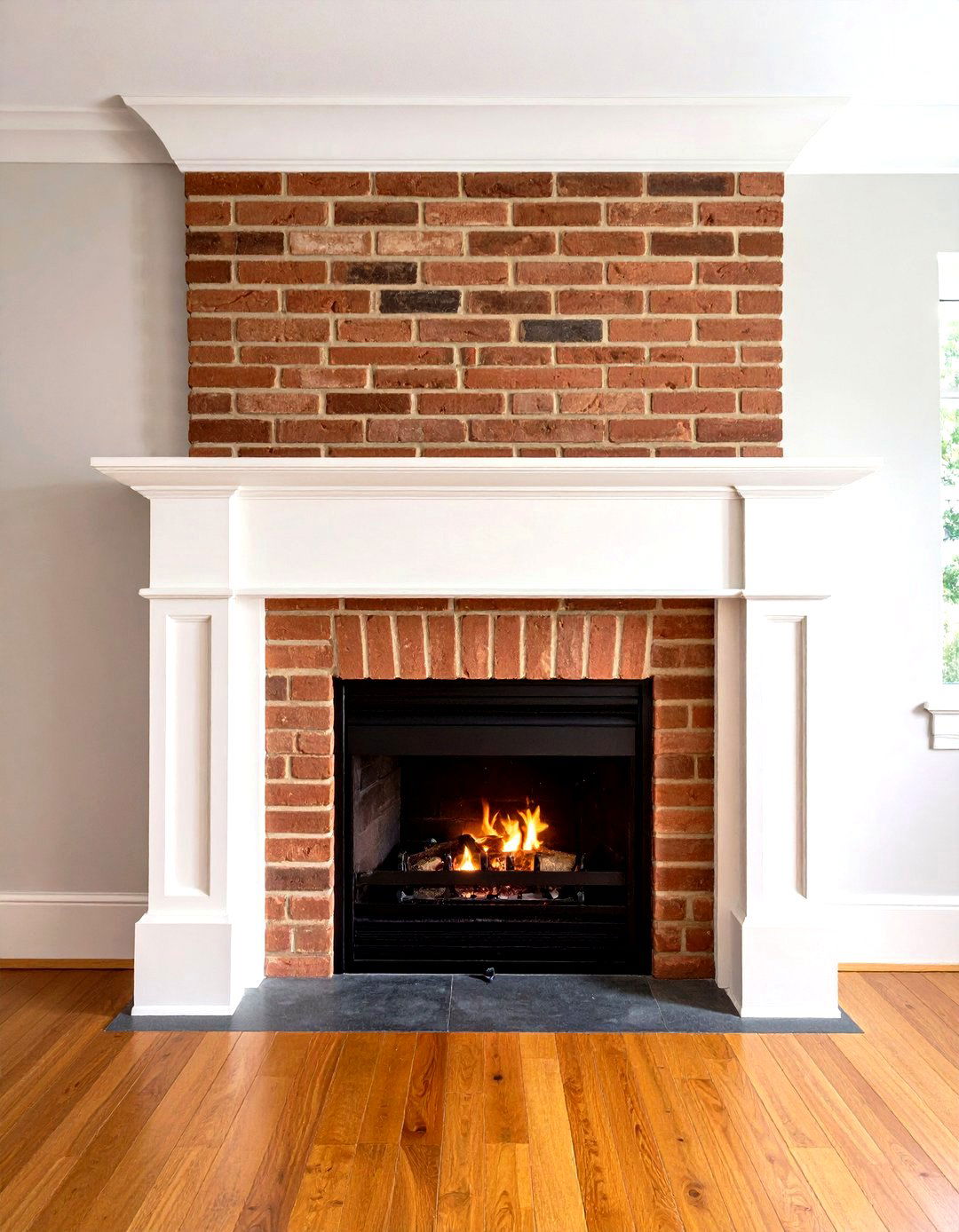
Colonial fireplaces reflect America's early architectural heritage through their clean lines, symmetrical proportions, and emphasis on functional beauty over ornamentation. These designs show European settler influences with practical approaches to heating that prioritized efficiency and durability. Colonial Revival mantels feature white-painted poplar or pine with symmetrical displays and understated elegance. Traditional materials include locally sourced stone and handmade brick arranged in simple, geometric patterns. The classic white-painted mantel remains a hallmark feature, often crafted from pine or maple for natural wood finishes. Maintain authenticity by choosing period-appropriate hardware and keeping decorative elements minimal. These timeless fireplaces work beautifully in both historic homes and contemporary spaces seeking classic American charm.
5. Craftsman Fireplace Character
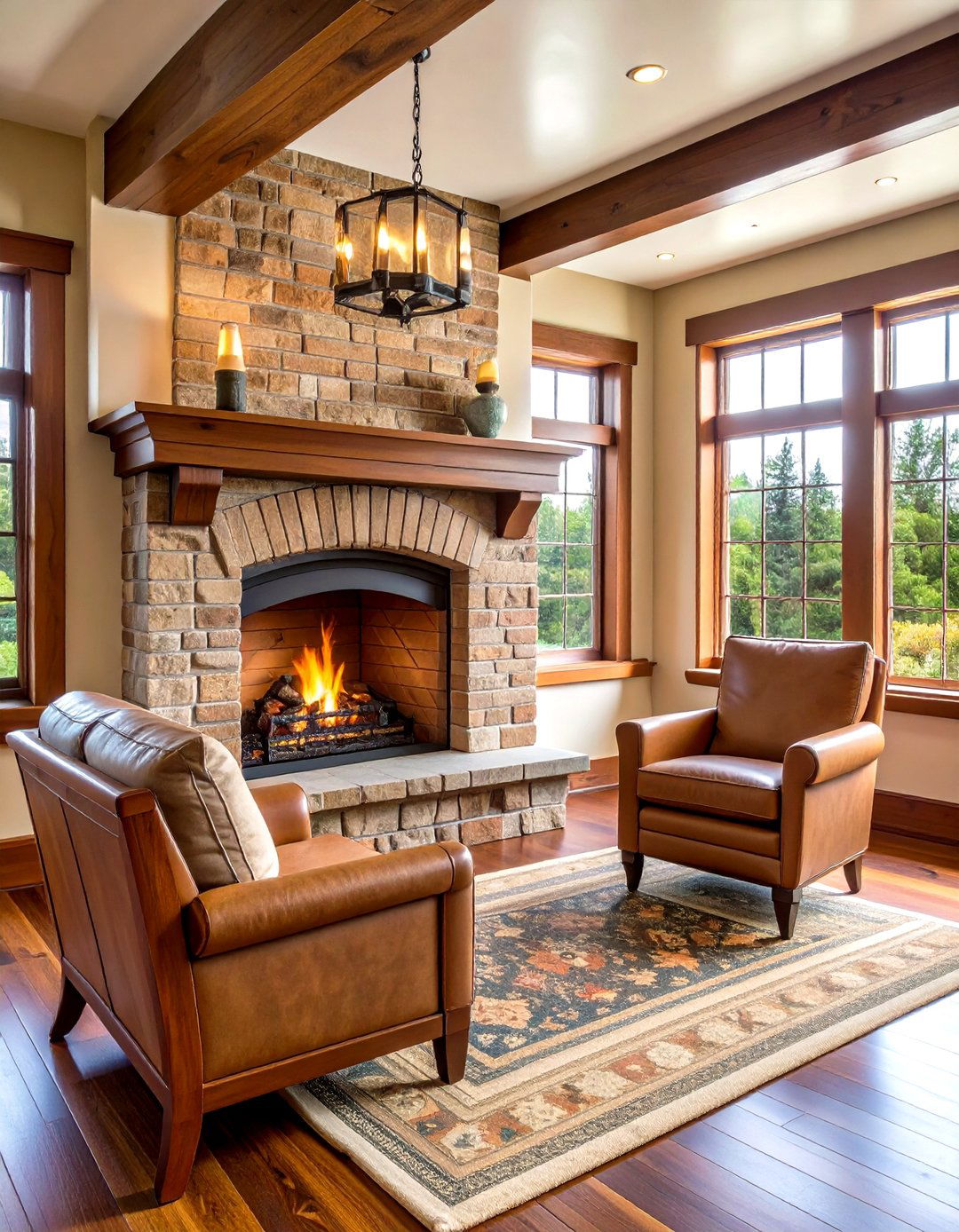
Craftsman fireplaces embody the Arts and Crafts movement's philosophy of handcrafted beauty, natural materials, and functional design that celebrates authentic workmanship. These designs feature prominent use of local stone, clinker brick, and rich woodwork with built-in seating and cozy proportions. Roman brick, favored by Frank Lloyd Wright, measures narrower than standard brick and creates distinctive horizontal lines in Prairie-style fireplaces. Characteristic elements include beveled mirrors, ochre art tiles, and quarter-sawn oak mantels with rich, deep stains. The integration of built-in furniture and natural lighting enhances the cozy atmosphere. Choose earthy color palettes and emphasize horizontal lines to maintain authentic Craftsman appeal. These fireplaces create inviting gathering spaces that celebrate the beauty of honest materials and skilled craftsmanship.
6. Marble Fireplace Sophistication
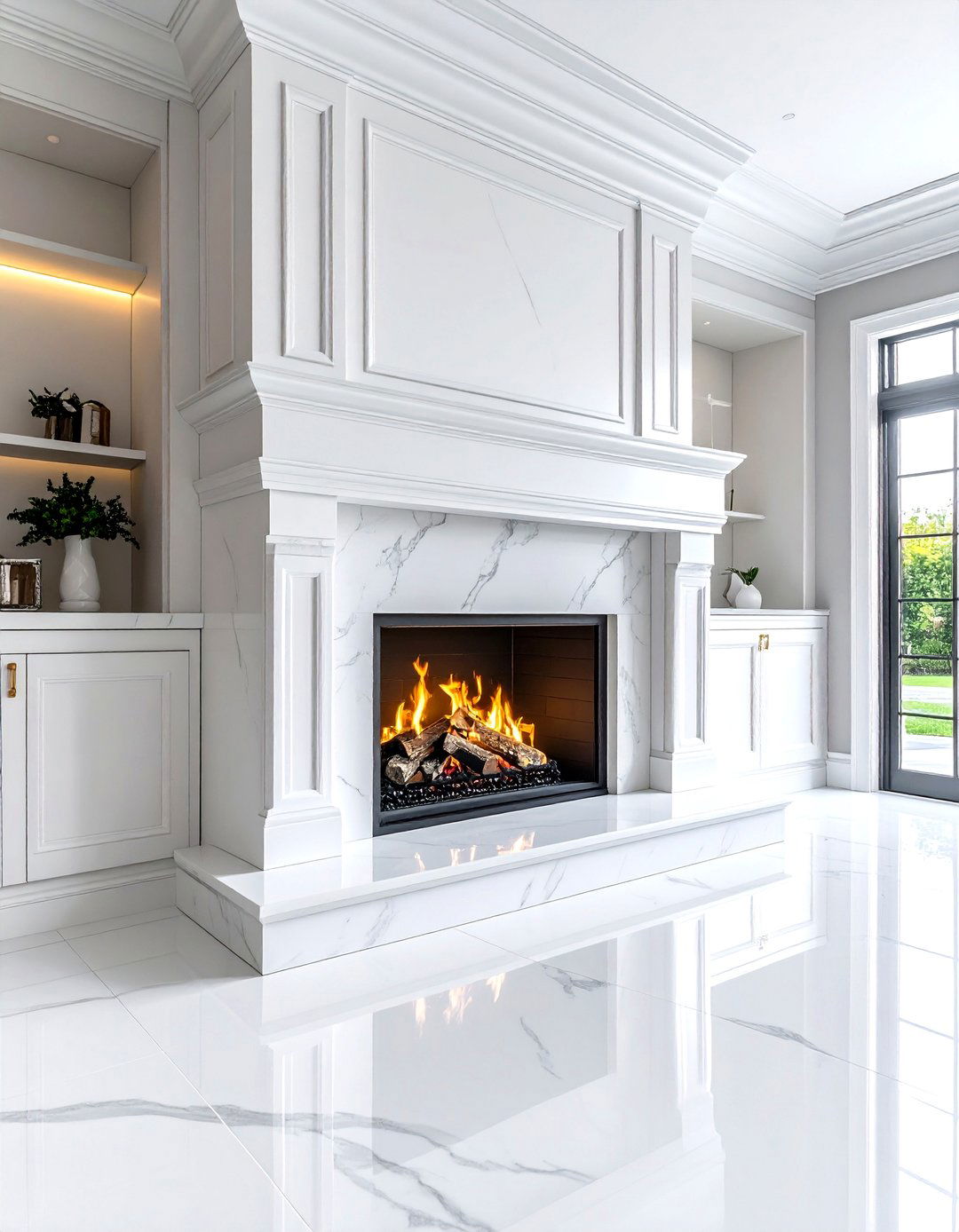
Marble fireplaces represent the pinnacle of elegant home design, offering luxurious beauty that has graced prestigious homes for centuries. White marble provides classic, timeless appeal while colored variations like black or veined marble create dramatic contemporary statements. Modern applications feature geometric lines with concentric rectangles inspired by Art Deco movement, creating stunning focal points. Installation requires professional expertise due to the material's weight and the precision needed for seamless joints. Different marble types offer unique characteristics—some varieties may have slight sensitivities to acidic conditions, requiring proper care procedures. Regular maintenance involves gentle cleaning with specialized stone products and periodic professional sealing. The investment in marble creates lasting value and unmatched sophistication that elevates any living space.
7. Traditional Wood Mantel Designs

Wood mantels serve as the crowning element of traditional fireplaces, providing warmth, storage, and display opportunities that define a room's character. Materials range from reclaimed barn wood for rustic charm to carved oak for formal elegance, with each choice creating distinct aesthetic appeal. Period-appropriate styles include Colonial Revival with white paint and symmetrical swags, and Craftsman designs featuring quarter-sawn white oak with rich staining. Custom carved mantels can incorporate historical elements like Gothic Tudor roses, French provincial details, or Victorian fleur-de-lys motifs. Proper installation requires secure mounting to handle decorative weight and thermal expansion. Choose wood species that complement your home's architectural style and existing millwork. Regular maintenance includes dusting, occasional refinishing, and protecting from excessive heat damage near the firebox opening.
8. Cast Iron Fireplace Components
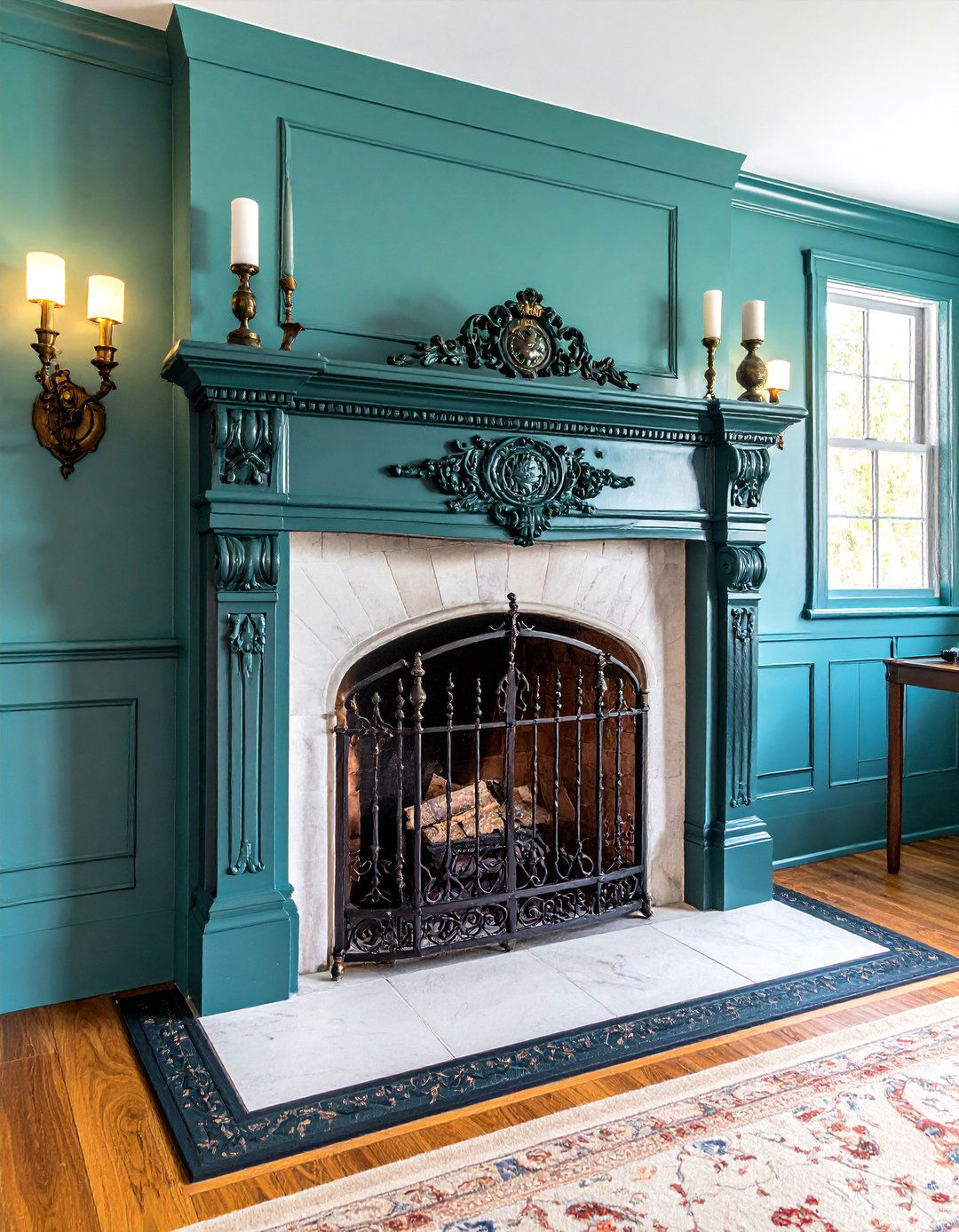
Cast iron elements bring industrial heritage and authentic Victorian character to traditional fireplaces through durable, decorative functionality that withstands decades of use. Victorian-era innovations included built-in metal grates for coal burning and mass-produced cast iron surrounds that made fireplaces affordable for working classes. These components featured extraordinary attention to detail with ornate patterns, industrial imagery, and Gothic revival motifs that reflected the era's artistic expression. The Industrial Revolution enabled standardized fireplace sizes instead of relying on individual craftsman judgment, making installation more predictable. Modern reproductions offer authentic styling with updated safety features. Maintain cast iron through regular cleaning, rust prevention, and appropriate heat-resistant finishes. These robust components provide both decorative appeal and practical functionality, creating authentic period atmosphere in traditional fireplace designs.
9. Traditional Hearth Materials

The hearth serves as both protective and aesthetic foundation for traditional fireplaces, requiring materials that withstand intense heat while complementing the overall design. Popular choices include flagstone for natural beauty, limestone for durability, and brick for classic charm, each offering distinct visual and practical benefits. Victorian fireplaces often featured marble hearths paired with cast iron surrounds, creating elegant contrasts that defined sophisticated interiors. Proper hearth extension protects surrounding floors from sparks and embers while meeting local fire codes. Stone hearths can be sealed to prevent stains, while brick requires more frequent maintenance due to its porous nature. Consider the room's traffic patterns and furniture placement when selecting hearth materials. Professional installation ensures proper fire resistance and structural integrity. These foundational elements ground the fireplace design while providing essential safety protection.
10. Rustic Fieldstone Fireplace Appeal
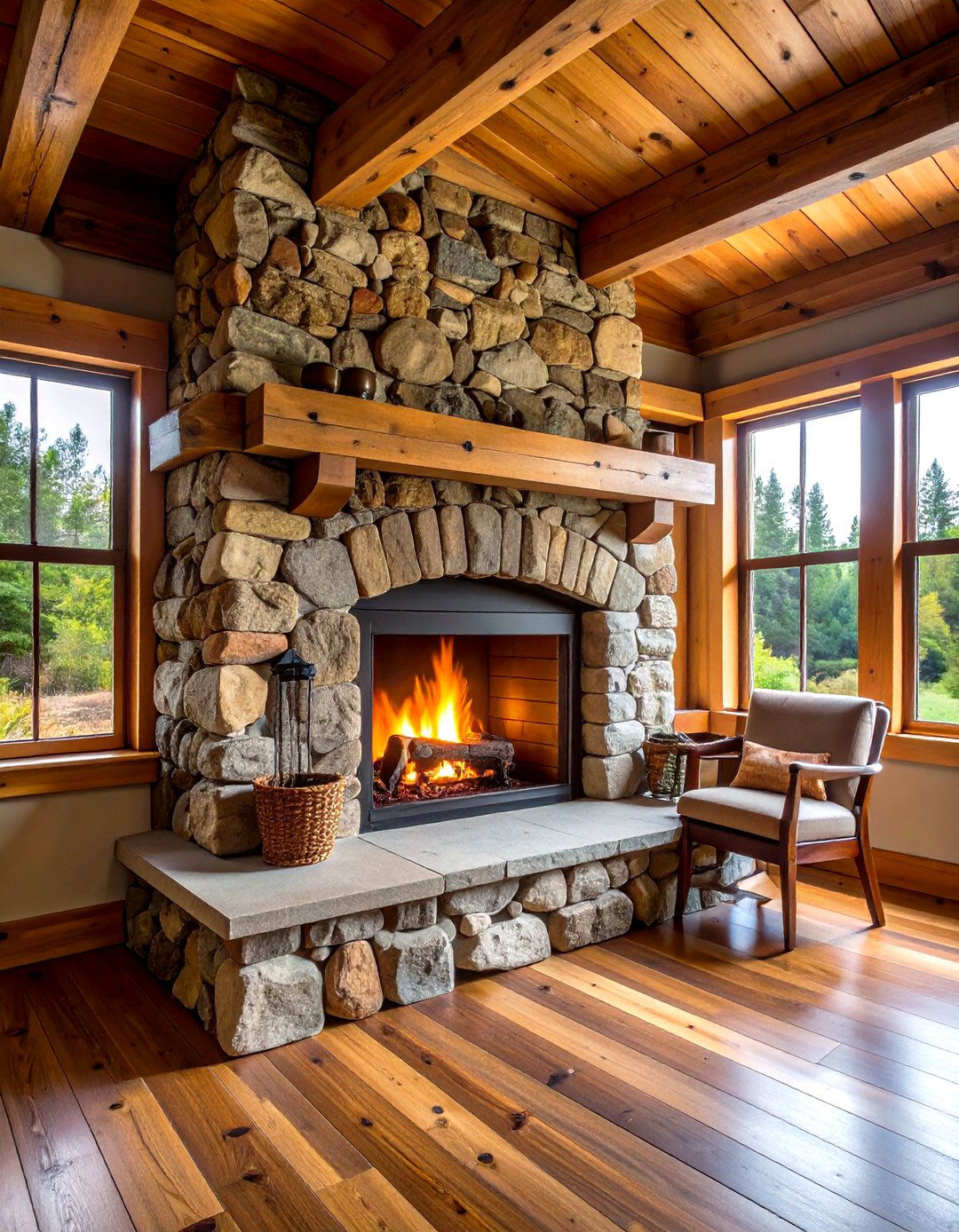
Fieldstone fireplaces capture the essence of countryside living through their organic shapes, natural variations, and authentic connection to local geology. These rocks collected from fields create rustic appeal in minimalist settings while bringing textural contrast to contemporary spaces. The organic, textured surface of fieldstone contrasts beautifully with smooth architectural elements and provides natural focal points in great room settings. Installation requires skilled masons who understand how to fit irregular shapes while maintaining structural integrity. Each stone's unique character means no two fieldstone fireplaces look identical, creating truly custom installations. Fieldstone works exceptionally well in cabin settings where dark tones complement wood plank walls for authentic rustic atmosphere. Maintenance involves checking mortar joints and cleaning with appropriate stone care products. These timeless designs celebrate natural beauty while providing reliable warmth and rustic charm.
11. Georgian Fireplace Proportions

Georgian fireplaces embody classical architectural principles through balanced proportions, refined details, and understated elegance that defined 18th-century British design influence. Period mantels featured carved lindenwood elements, Georgian styling, and furniture-quality construction with sophisticated proportional relationships. Early Victorian designs still reflected Georgian and Regency classical influences before evolving toward more elaborate decorative approaches. These designs emphasize mathematical harmony with precise mantel heights, proportional pilasters, and balanced decorative elements. Traditional Georgian colors include soft whites, muted grays, and subtle earth tones that enhance the refined aesthetic. Modern interpretations maintain classical proportions while incorporating contemporary conveniences. Choose quality millwork that reflects period craftsmanship standards. Professional installation ensures proper proportional relationships between hearth, surround, and mantel elements. These timeless designs provide sophisticated focal points that complement both traditional and transitional interior styles.
12. Traditional Chimney Construction

Traditional chimney design combines functional engineering with architectural beauty, creating vertical elements that define rooflines while ensuring safe smoke evacuation. Masonry chimneys require regular inspection for cracks, loose brickwork, and proper chimney cap installation to prevent water damage and animal intrusion. Most wood-burning fireplaces use heavy masonry construction on solid foundations, while some feature factory-built systems with triple-wall stainless steel chimneys. Chimney caps prevent debris accumulation while mesh screening arrests sparks and allows smoke escape. Proper maintenance includes annual professional inspections, creosote removal, and flashing repairs. Tree limbs should be trimmed away from chimneys to prevent fire hazards and structural damage during storms. Traditional brick or stone exterior finishes should match the home's architectural style. These essential components require professional expertise for safe operation and long-term reliability.
13. Authentic Tile Work Patterns
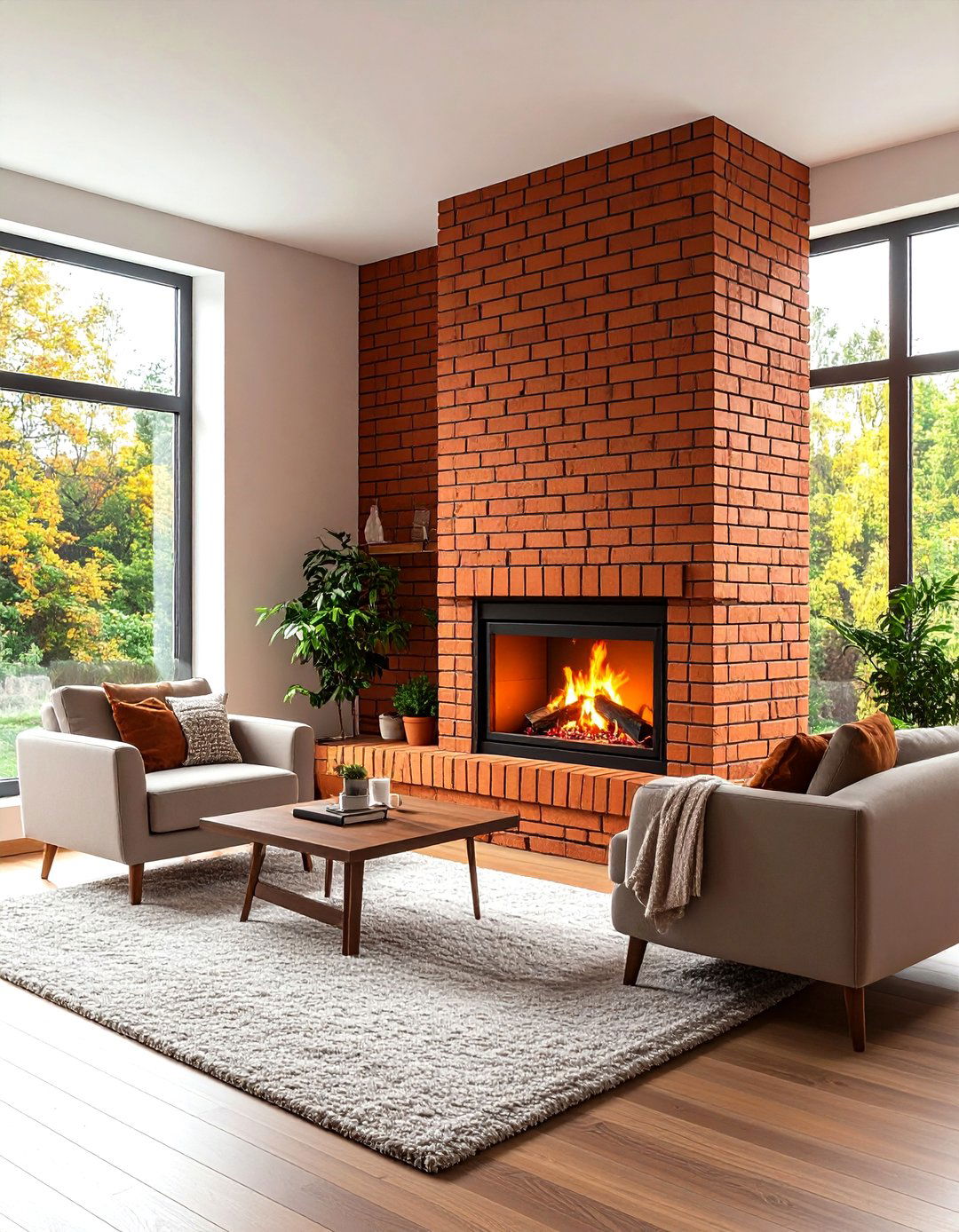
Traditional fireplace tiles showcase artistic craftsmanship through intricate patterns, rich glazes, and cultural motifs that transform functional surfaces into decorative masterpieces. Arts and Crafts period tiles featured square field tiles in mottled browns and greens, with inventive surround patterns especially in brick and tile combinations. Victorian tile work used encaustic tiles with handmade intricate patterns and vibrant colors, plus transfer-printed tiles for detailed mass-produced designs. Period installations featured William Morris designs, De Morgan ships and fantastic birds, and Voysey patterns that created stunning visual focal points. Modern reproduction tiles capture authentic period aesthetics while meeting contemporary installation standards. Choose grout colors that complement tile tones and enhance pattern definition. Professional installation by experienced tile masons ensures proper heat resistance and longevity. These decorative elements add cultural richness and artistic expression to traditional fireplace designs.
14. Corner Fireplace Configurations
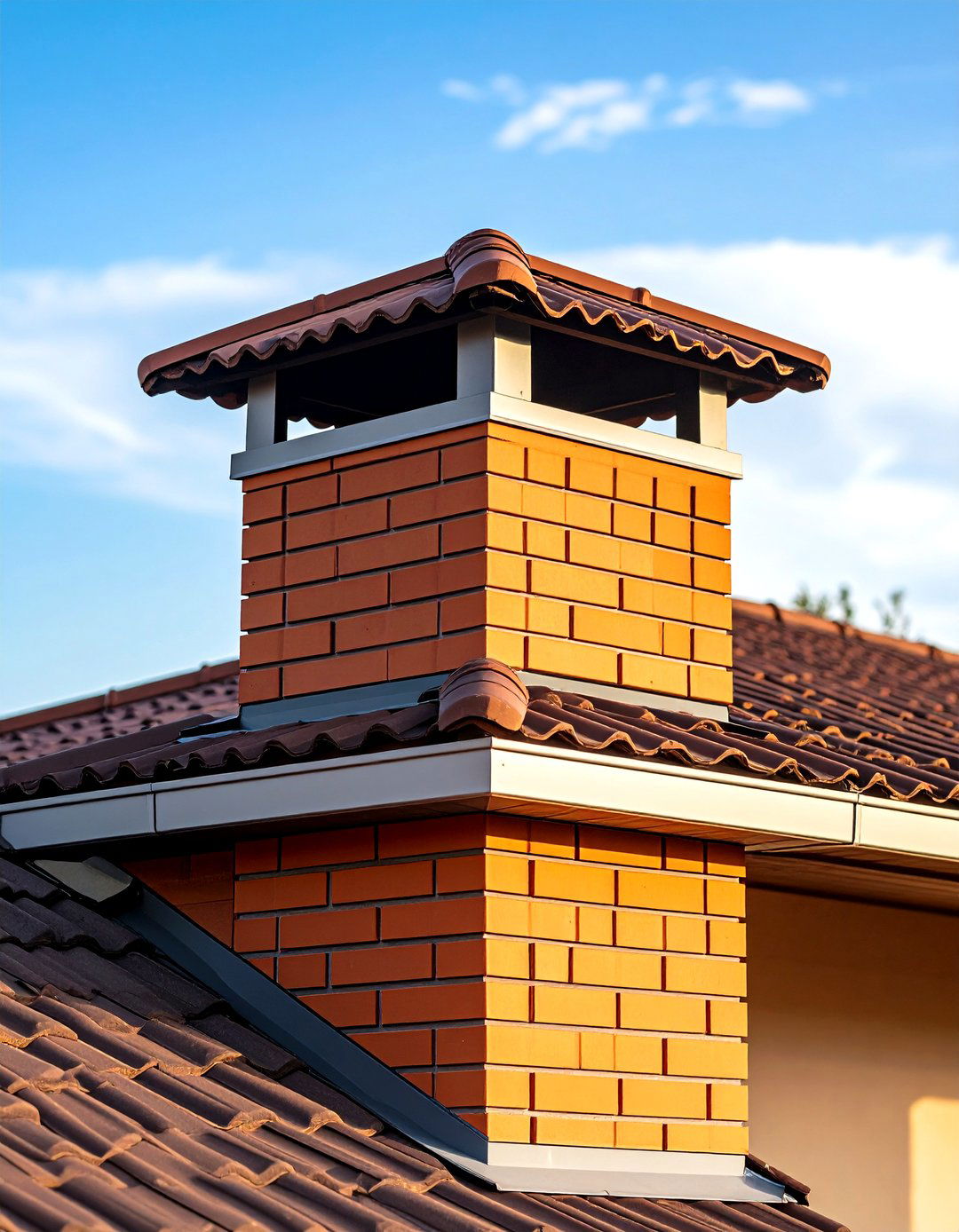
Corner fireplaces maximize space efficiency while creating intimate seating arrangements that encourage conversation and relaxation in compact living areas. These dedicated spaces enhance room functionality while providing more seating arrangements for entertaining guests and visitors. Cone-shaped freestanding designs create groovy yet graceful focal points that allow for bold gallery walls directly behind them. Traditional corner installations often feature angled hearths and specialized mantels designed to fit angular spaces effectively. Dark stone corner fireplaces complement cabin aesthetics while maintaining rustic appeal in minimalist room corners. Consider furniture placement carefully to maximize the corner fireplace's warming efficiency and visual impact. Professional installation addresses unique venting requirements and structural considerations. These space-conscious designs work particularly well in smaller rooms where traditional centered fireplaces might overwhelm the space. Corner configurations create cozy intimate atmospheres while preserving valuable wall space for other functions.
15. Double-Sided Traditional Designs
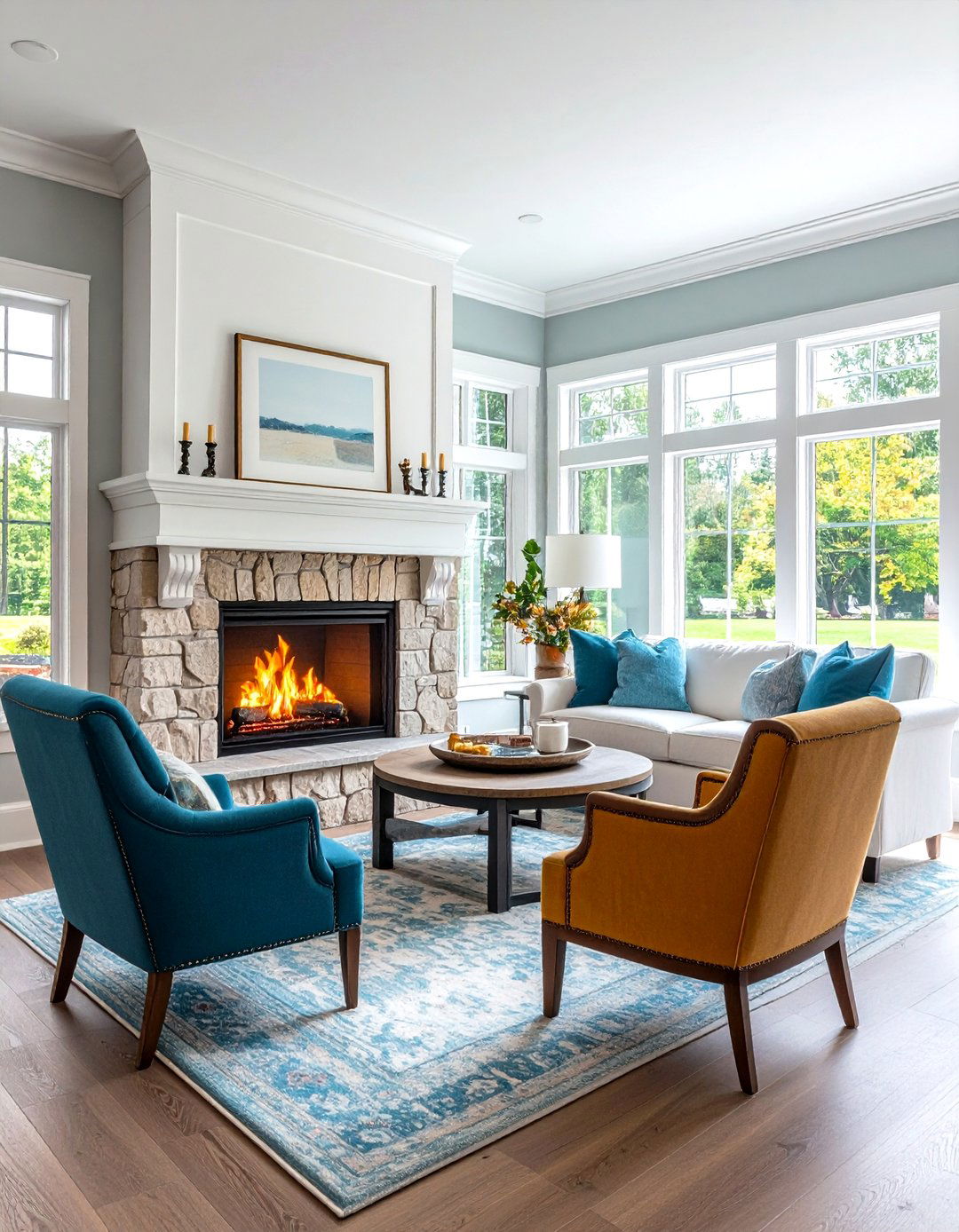
Double-sided fireplaces create architectural drama while connecting adjacent spaces through shared warmth and visual continuity that enhances open floor plans. These see-through designs serve as functional room dividers, offering warmth and fire views from two spaces simultaneously, such as living and dining areas. Multi-sided fireplaces expand viewing possibilities while adding architectural interest and ambiance to multiple rooms in creative new ways. Traditional materials like stone and brick work beautifully in double-sided configurations, creating substantial visual weight. Installation requires careful consideration of structural support and specialized venting systems. These designs allow heating of two adjacent areas simultaneously while creating wider entertainment spaces. Professional engineering ensures proper draft and safety in dual-opening systems. Maintenance involves cleaning both fireboxes and ensuring unobstructed airflow. These sophisticated installations create stunning focal points that unite separate living areas while maintaining distinct functional zones.
16. Traditional Fireplace Screen Selection

Fireplace screens provide essential safety protection while adding decorative elements that complement traditional design aesthetics and prevent ember escape. Quality screens prevent burning embers and ashes from leaving the firebox, keeping homes clean and safe from fire hazards. Traditional options include iron and brass fireplace tools that complement the overall style and degree of formality in period homes. Safety screens and barriers protect against serious burns from glass doors while maintaining proper clearances from flammable materials. Consider both functional protection and aesthetic appeal when selecting screens for traditional fireplaces. Materials should match other hardware elements like andirons and tool sets for cohesive appearance. Problems with ember migration typically indicate the need for new fireplace screens with better coverage. Proper sizing ensures complete fireplace opening coverage while allowing easy access for maintenance. Quality screens provide decades of reliable protection and enhance traditional fireplace safety.
17. Seasonal Maintenance Practices
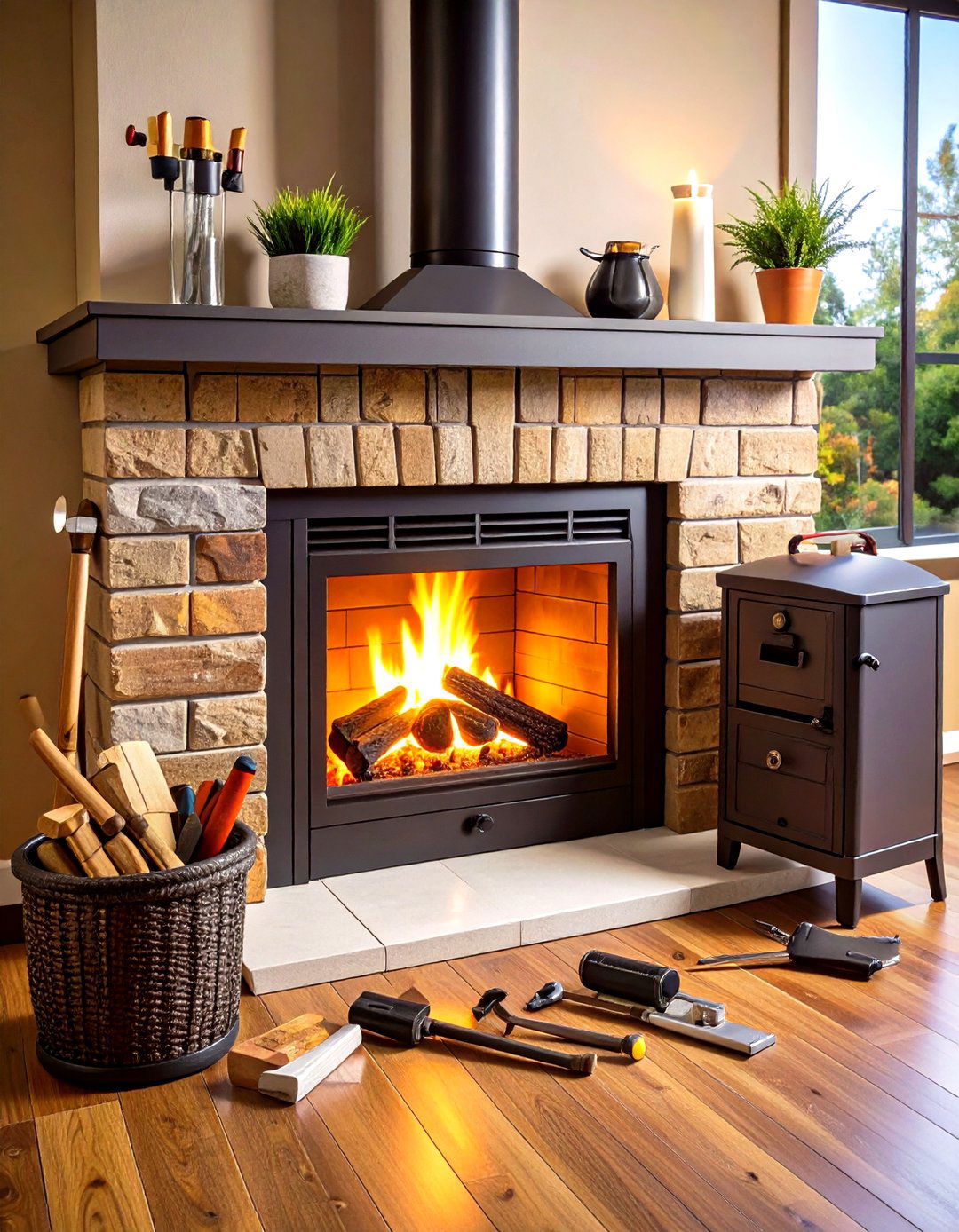
Effective seasonal maintenance ensures traditional fireplaces operate safely and efficiently throughout their lifespan while preserving their aesthetic appeal and structural integrity. Fall preparation includes chimney inspection, damper testing, and removing accumulated debris before the heating season begins. Wood-burning fireplaces require ash removal after each use, with cold ashes disposed of properly and thin ash layers left for insulation. During active use periods, clean glass doors with specialized cleaners and maintain proper airflow by keeping venting systems clear. Professional inspections should occur at least once per cord of wood burned, with occasional users needing service every two to three years. Spring and summer maintenance involves thorough cleaning, checking chimney caps, and trimming overhanging tree branches. Document all maintenance activities for warranty purposes and future reference. Proactive care prevents costly repairs and ensures safe operation.
18. Traditional Fuel Choices
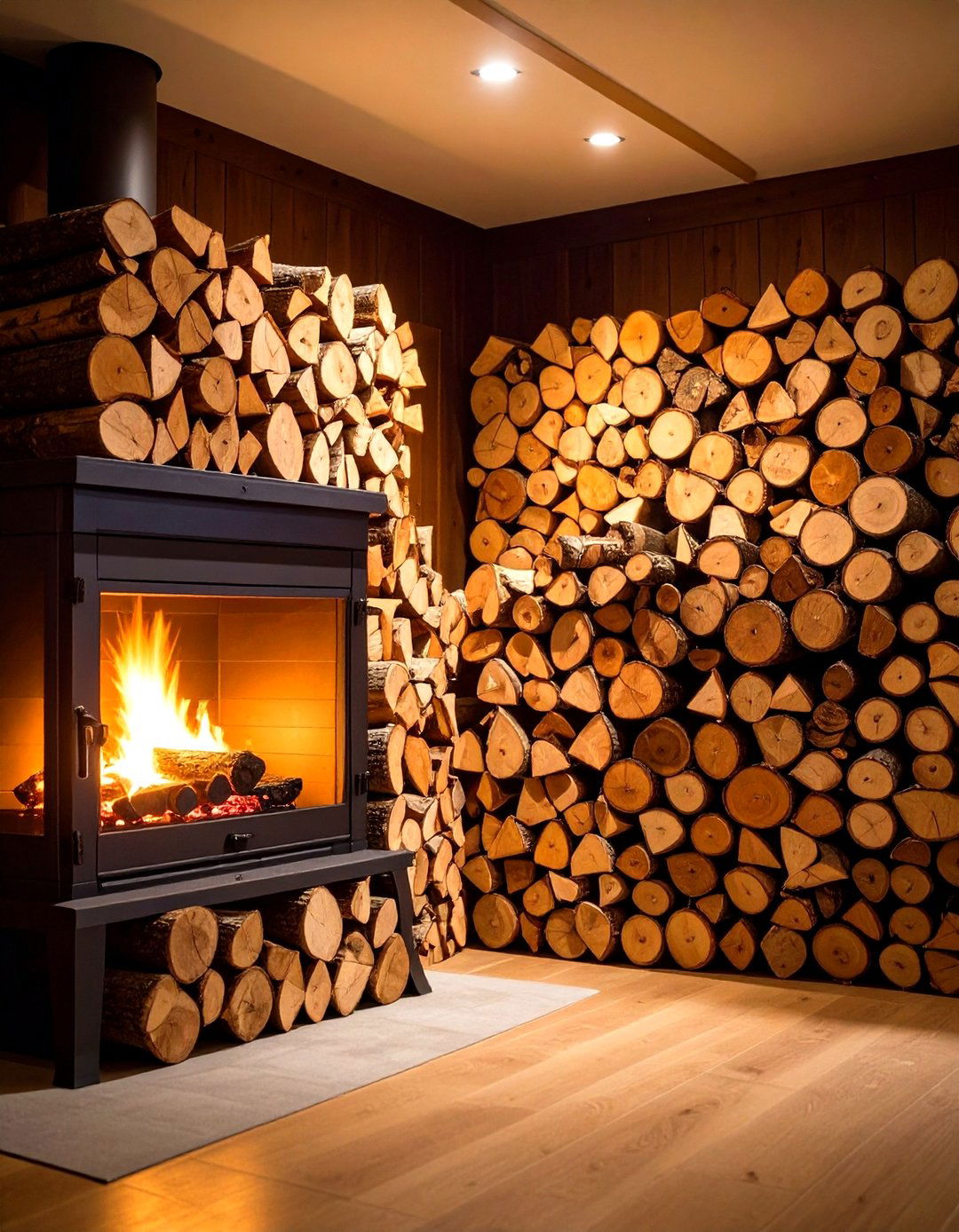
Selecting appropriate fuel types significantly impacts traditional fireplace performance, safety, and maintenance requirements while affecting the overall heating efficiency and ambiance. Use dried, well-seasoned hardwood like oak, maple, and birch that burns hot and completely, producing less creosote and carbon monoxide. Seasoned wood contains less than 20% moisture and should be dried for 6-12 months before burning to ensure optimal performance. Avoid softwoods like cedar and pine, and never use chemicals, gasoline, kerosene, or charcoal starter which create dangerous fire hazards. Stack firewood at least 30 feet away from your home and keep roof areas clear of leaves and debris. Proper wood selection affects cleaning frequency and chimney safety, with quality fuel reducing creosote buildup. Store wood in dry, ventilated areas to maintain optimal moisture content. Quality fuel choices enhance heating efficiency while minimizing maintenance requirements and safety concerns.
19. Heritage Restoration Techniques

Restoring traditional fireplaces requires specialized knowledge of historical construction methods, appropriate materials, and period-accurate techniques that preserve authentic character while ensuring modern safety. Successful restoration involves keeping existing brick as structural base while covering with appropriate materials to achieve built-in appearance. Victorian fireplace restoration focuses on preserving original craftsmanship quality visible in tiles, mantelpieces, and cast-iron grates. Period-appropriate upgrades should respect original style while meeting contemporary needs, avoiding unnecessary modifications to authentic features. Research historical records and local architectural surveys to understand original design intent. Work with craftspeople experienced in traditional building methods and period materials. Document existing conditions thoroughly before beginning restoration work for future reference and warranty purposes. Balance historical accuracy with modern safety codes and efficiency standards. Professional restoration preserves cultural heritage while creating functional heating systems for contemporary use.
20. Safety Considerations for Traditional Fireplaces
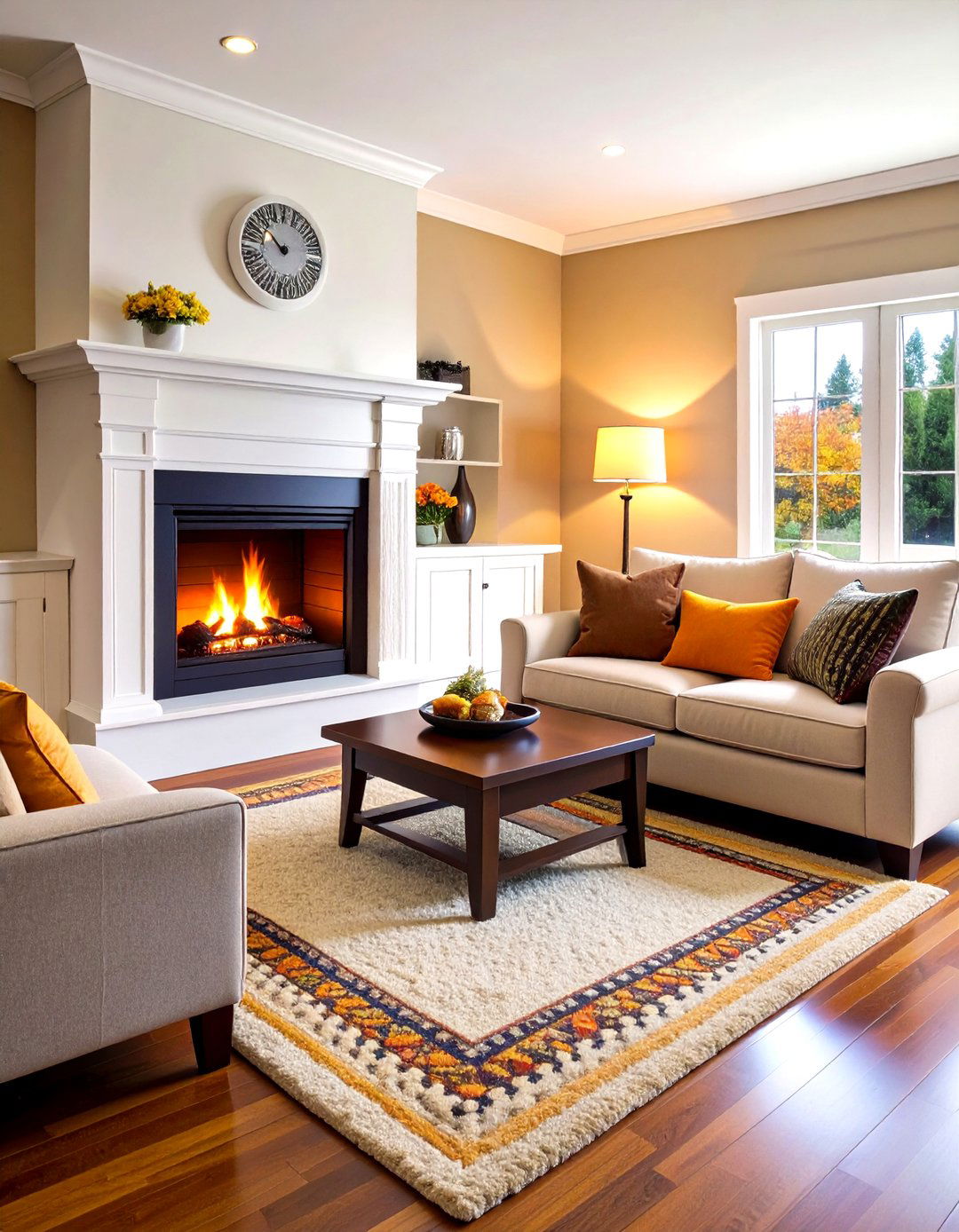
Traditional fireplace safety requires understanding potential hazards, implementing protective measures, and maintaining vigilant practices that protect families while preserving these beloved home features. Install carbon monoxide and smoke detectors, maintain 3-foot clearances from flammable materials, and never leave fires unattended when sleeping or leaving home. Regular professional inspections identify structural issues, creosote buildup, and ventilation problems that could create fire hazards. Allow ashes to cool completely before disposal in covered metal containers located at least 10 feet from buildings. Check smoke alarms monthly, replace batteries annually, and maintain clear sensors for optimal detection capability. Keep combustible materials away from hearths and use non-flammable rugs in fireplace areas. Gas and electric fireplaces require different safety protocols including gas leak detection and electrical system inspections. Educate family members about proper fireplace operation and emergency procedures for comprehensive safety protection.
Conclusion:
Traditional fireplaces continue to captivate homeowners with their timeless appeal, combining historical craftsmanship with practical functionality that creates lasting value in modern homes. From classic brick surrounds to elegant marble mantels, these heating features serve as architectural focal points that anchor living spaces while providing authentic warmth and ambiance. Whether embracing Victorian grandeur with ornate tilework or Craftsman simplicity with natural materials, traditional fireplace designs offer diverse options that complement various architectural styles. Success with these installations requires understanding proper materials, maintenance requirements, and safety considerations that ensure decades of reliable operation. Regular professional inspections, appropriate fuel selection, and seasonal maintenance protect both the fireplace investment and family safety. By respecting traditional design principles while incorporating modern safety standards, homeowners can enjoy the enduring charm and comfort that traditional fireplaces bring to contemporary living spaces.




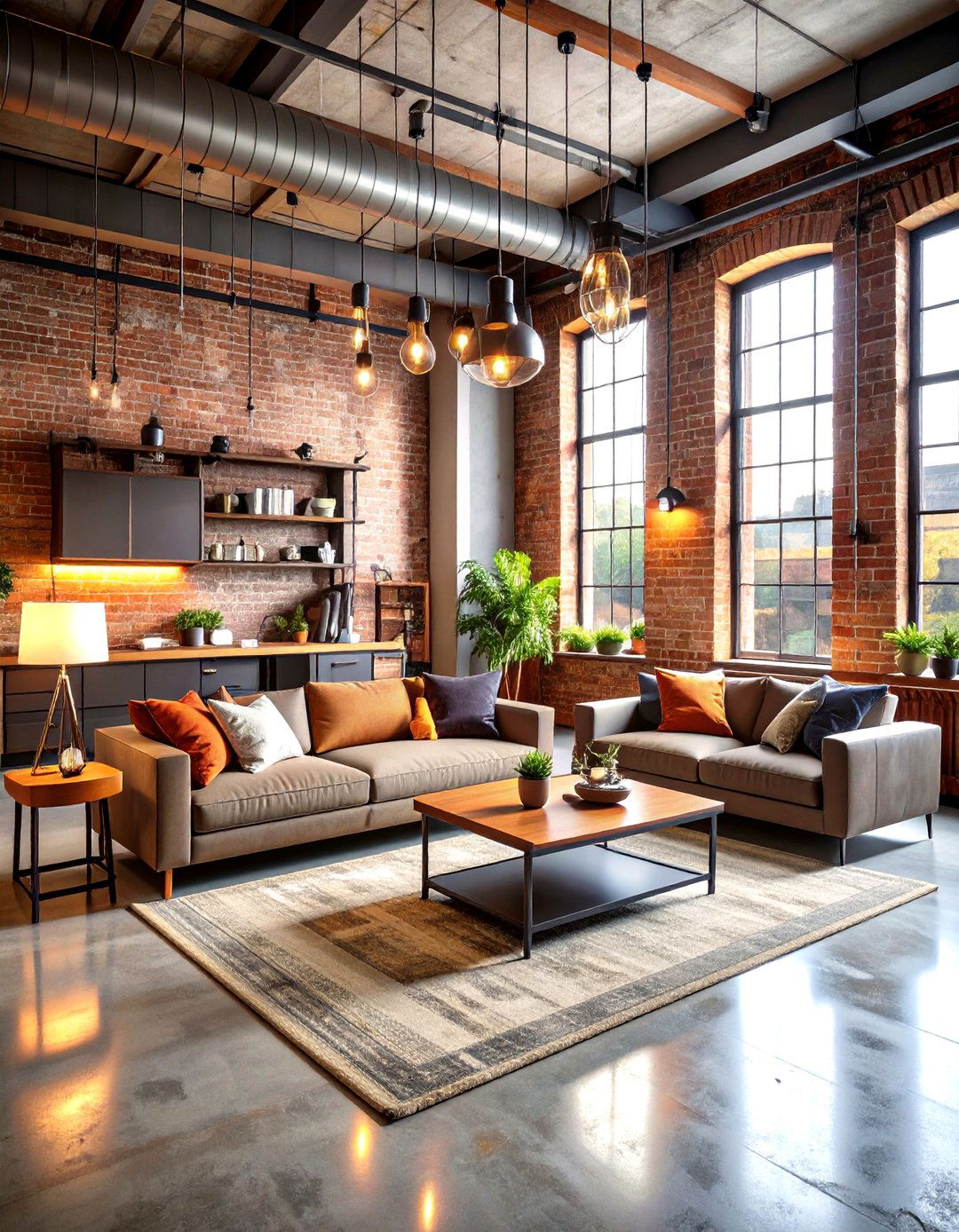

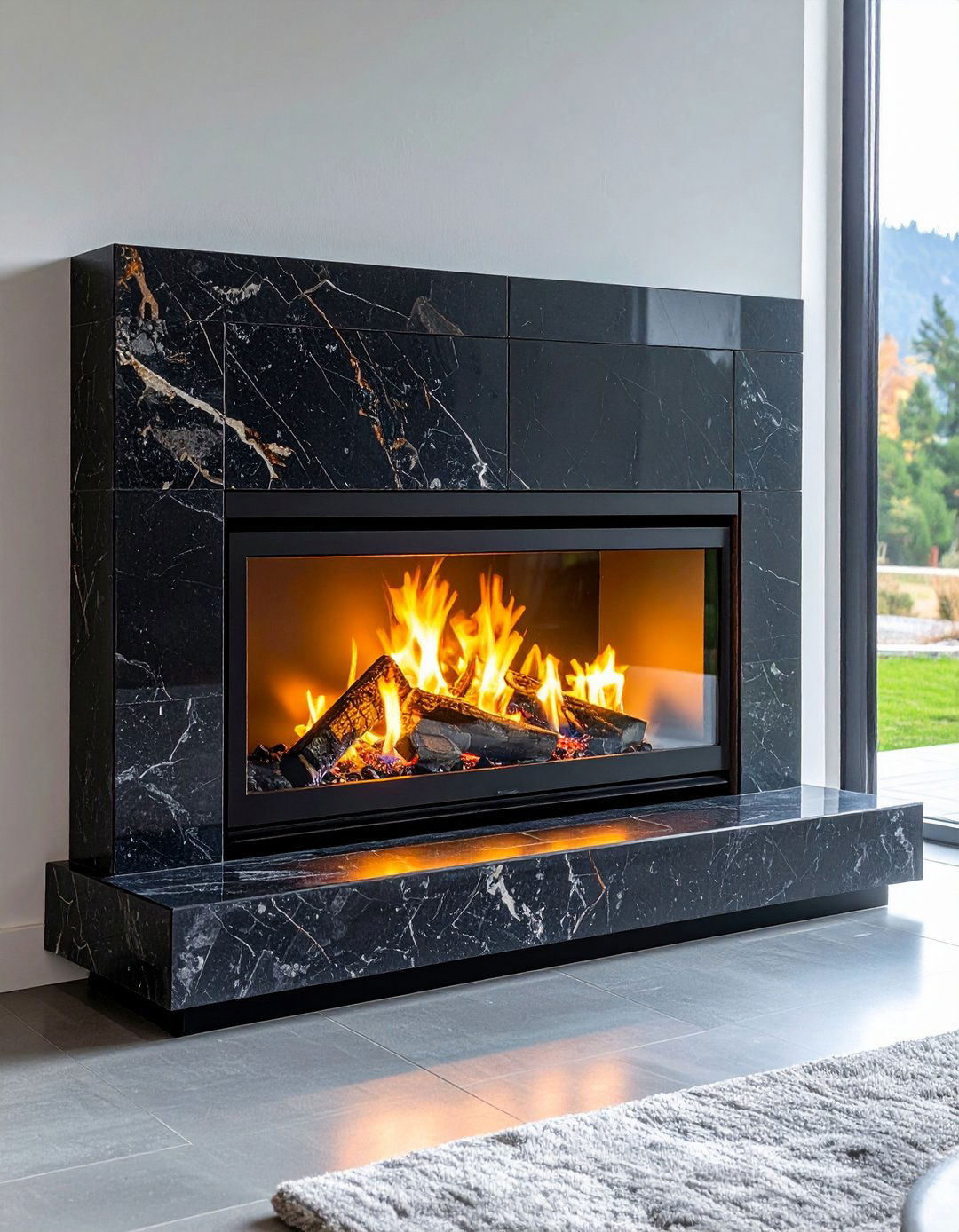
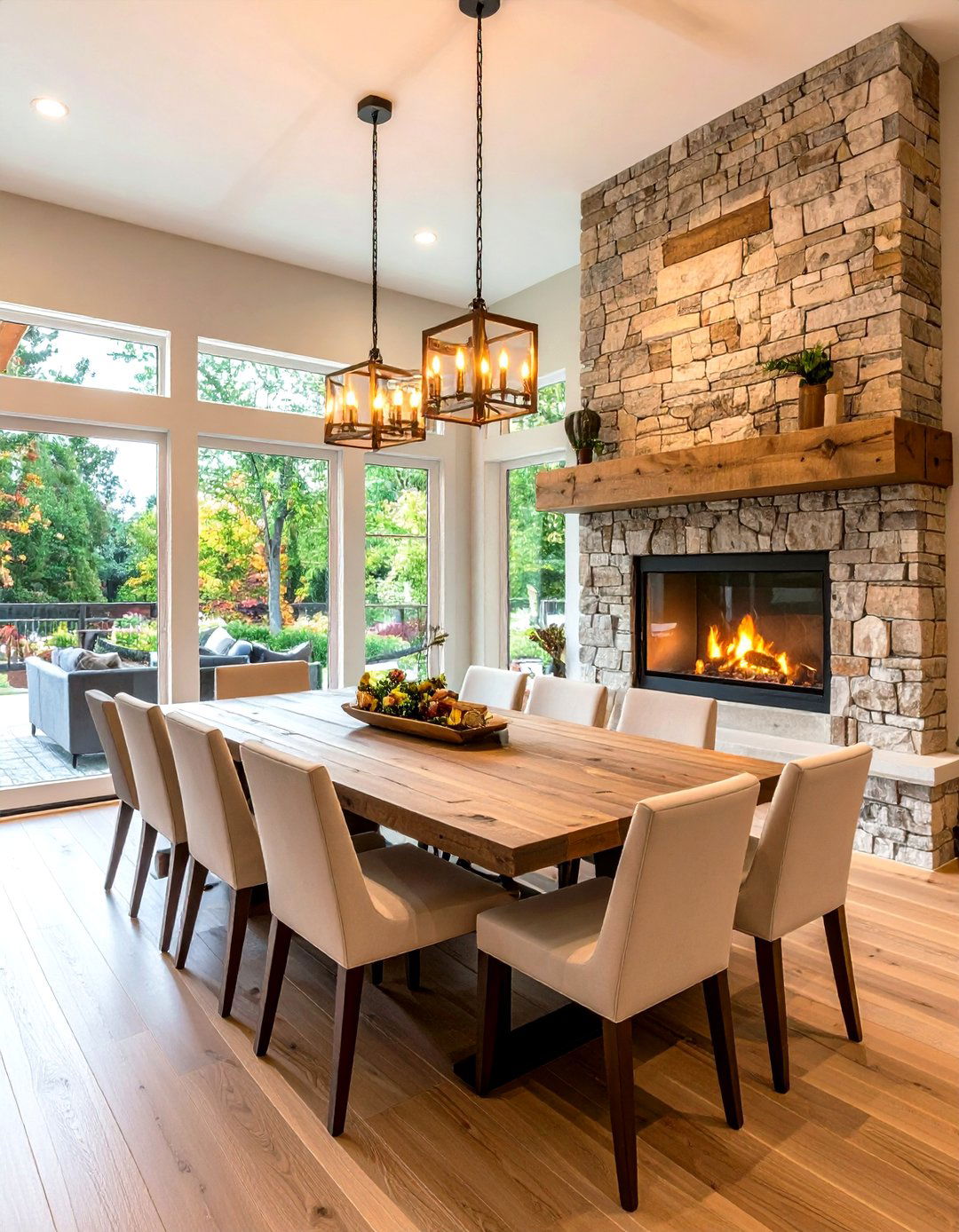
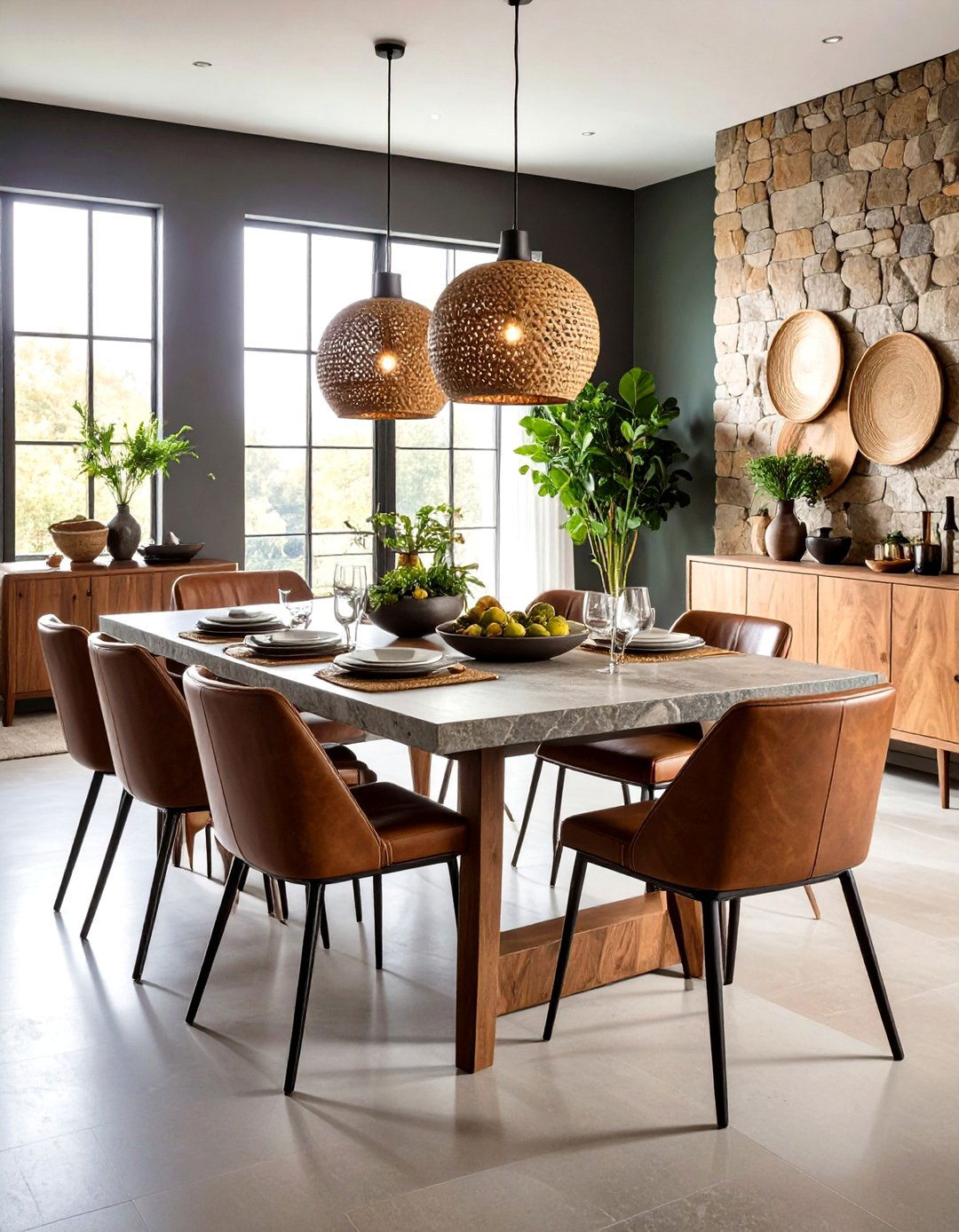
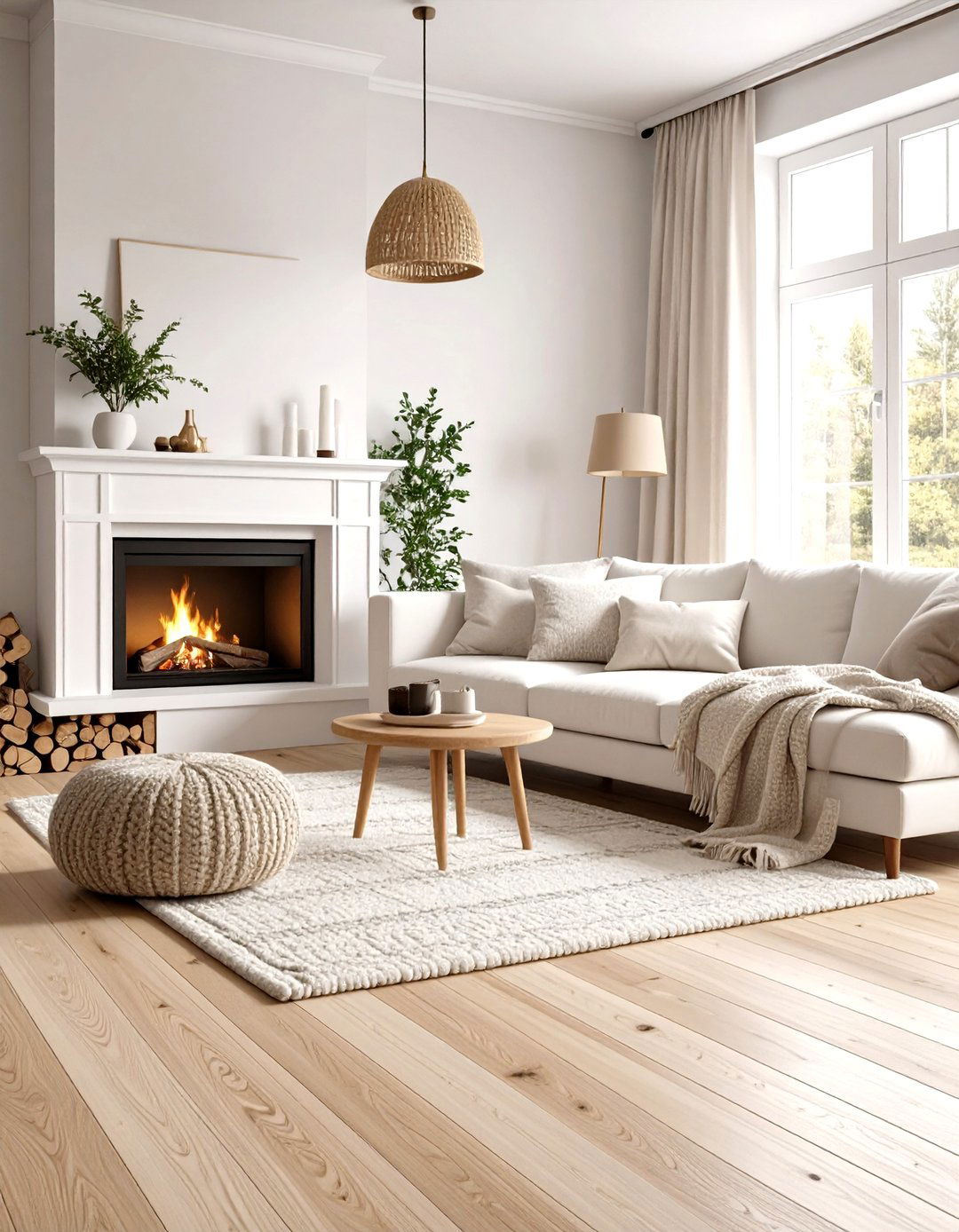

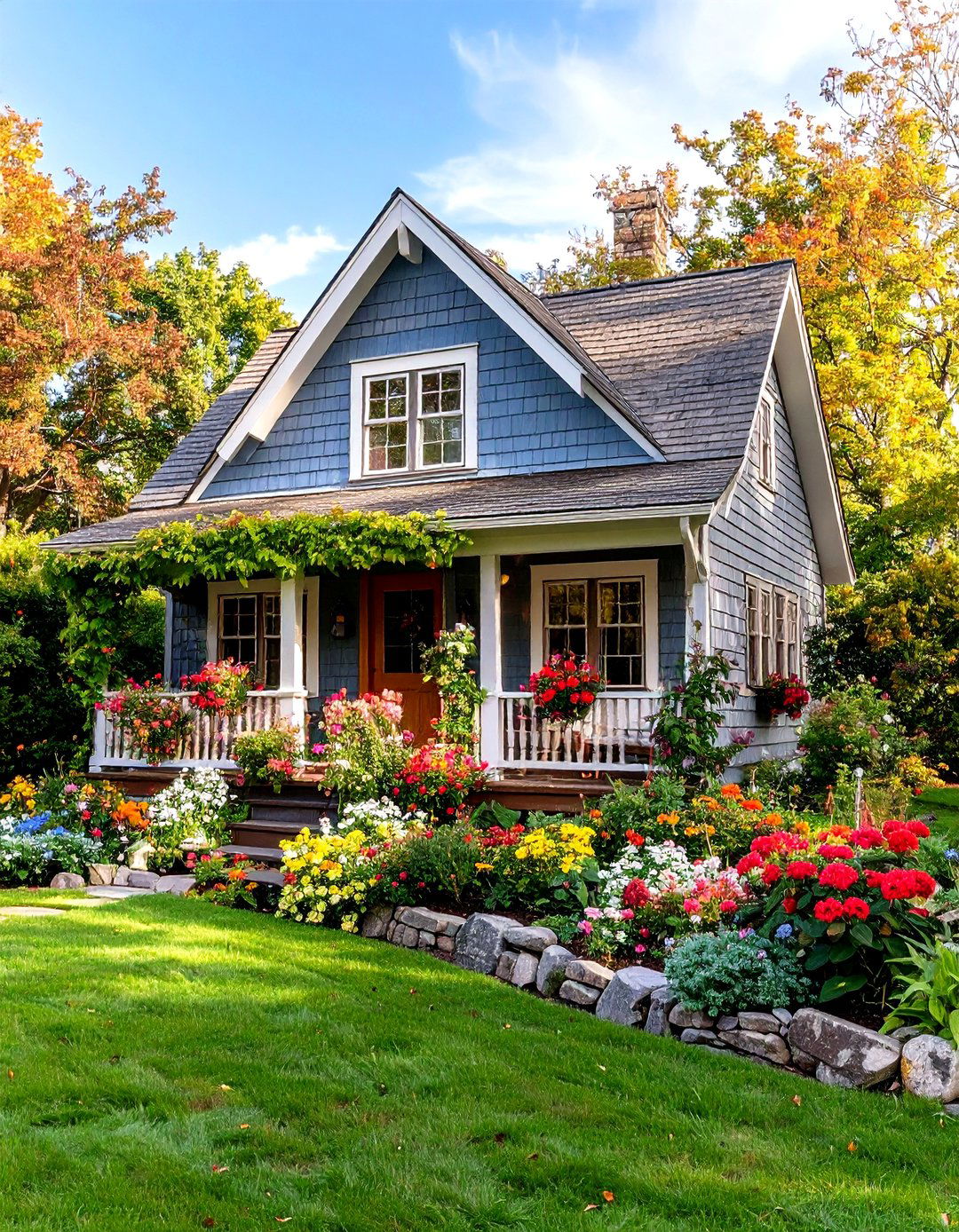
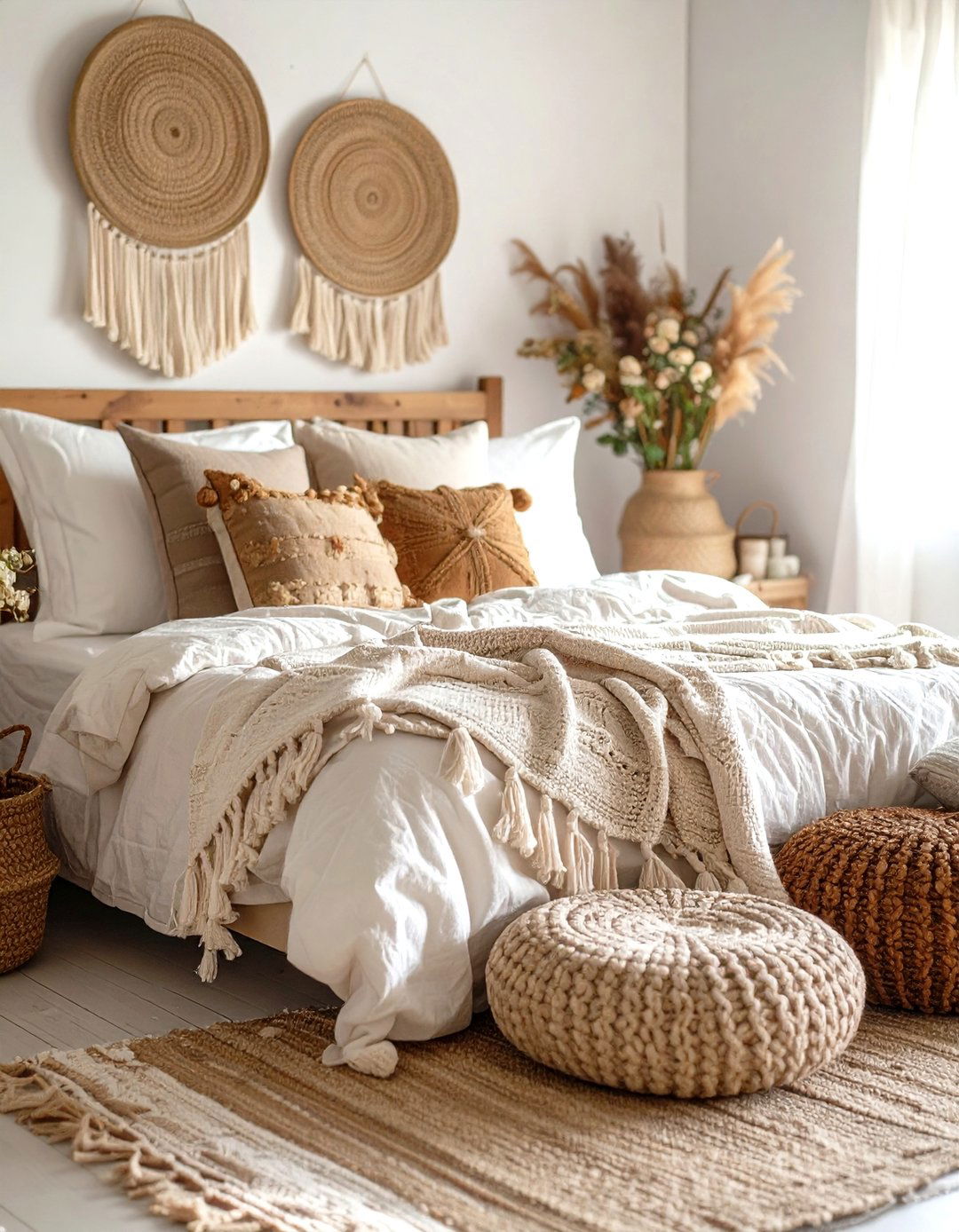
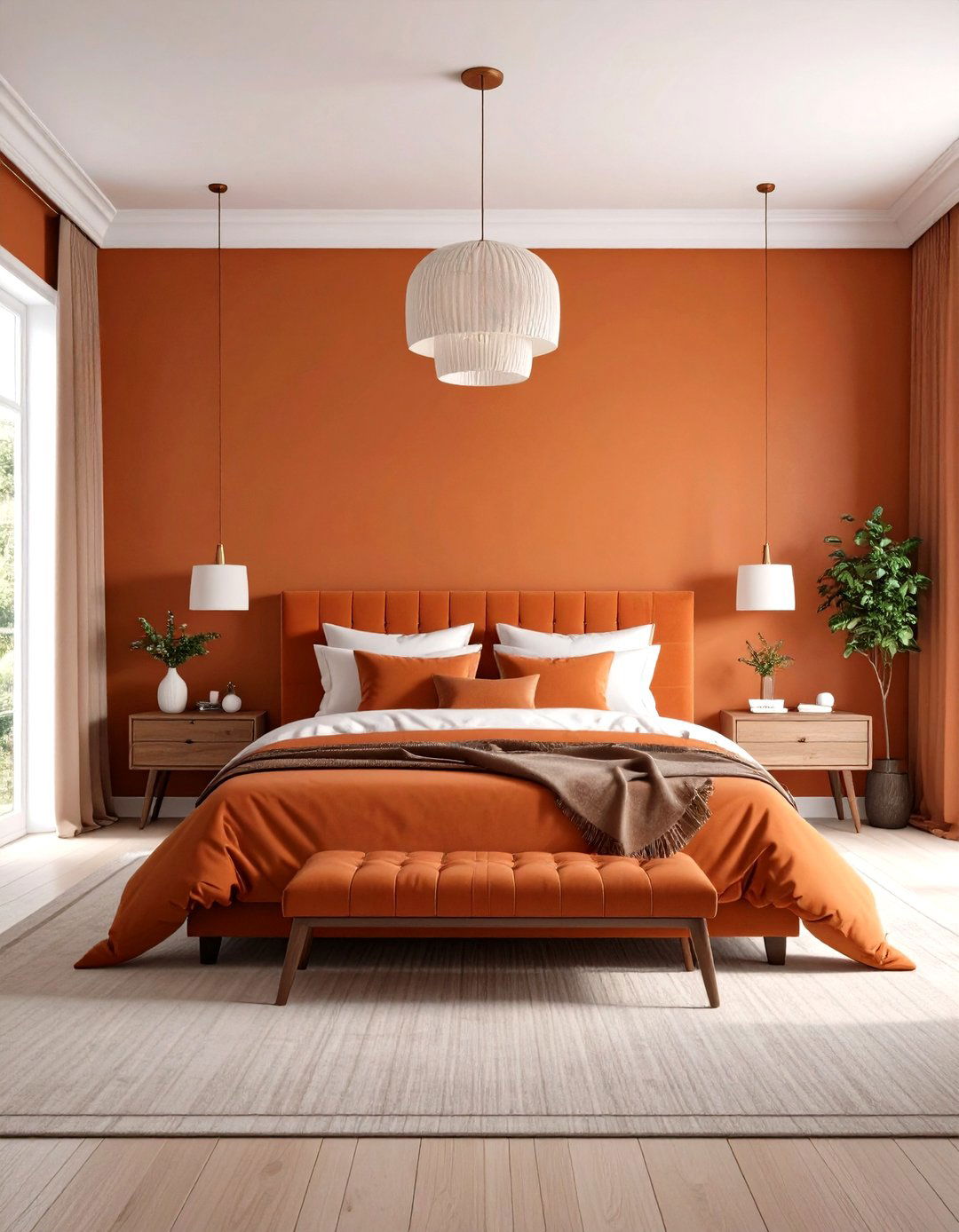
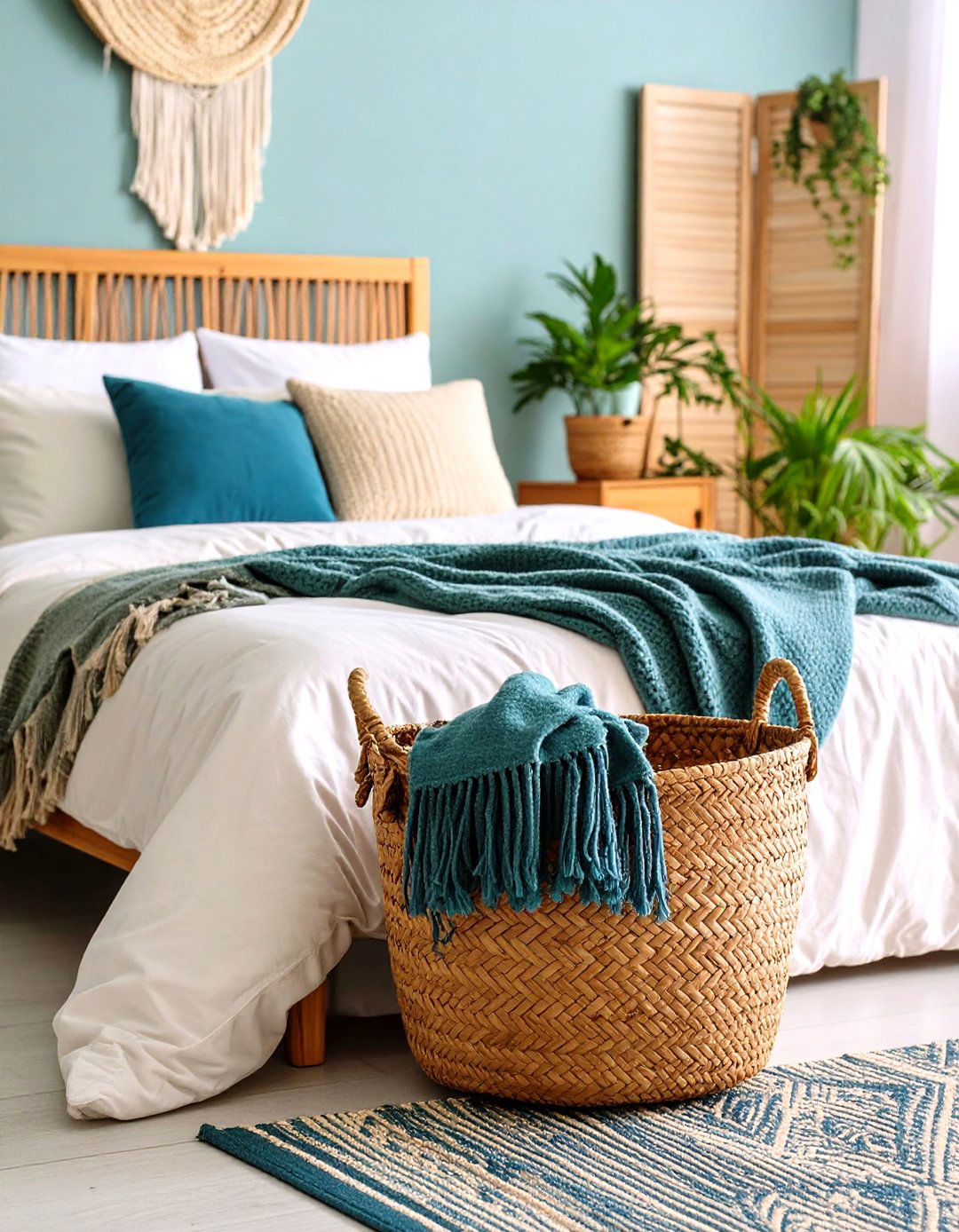

Leave a Reply